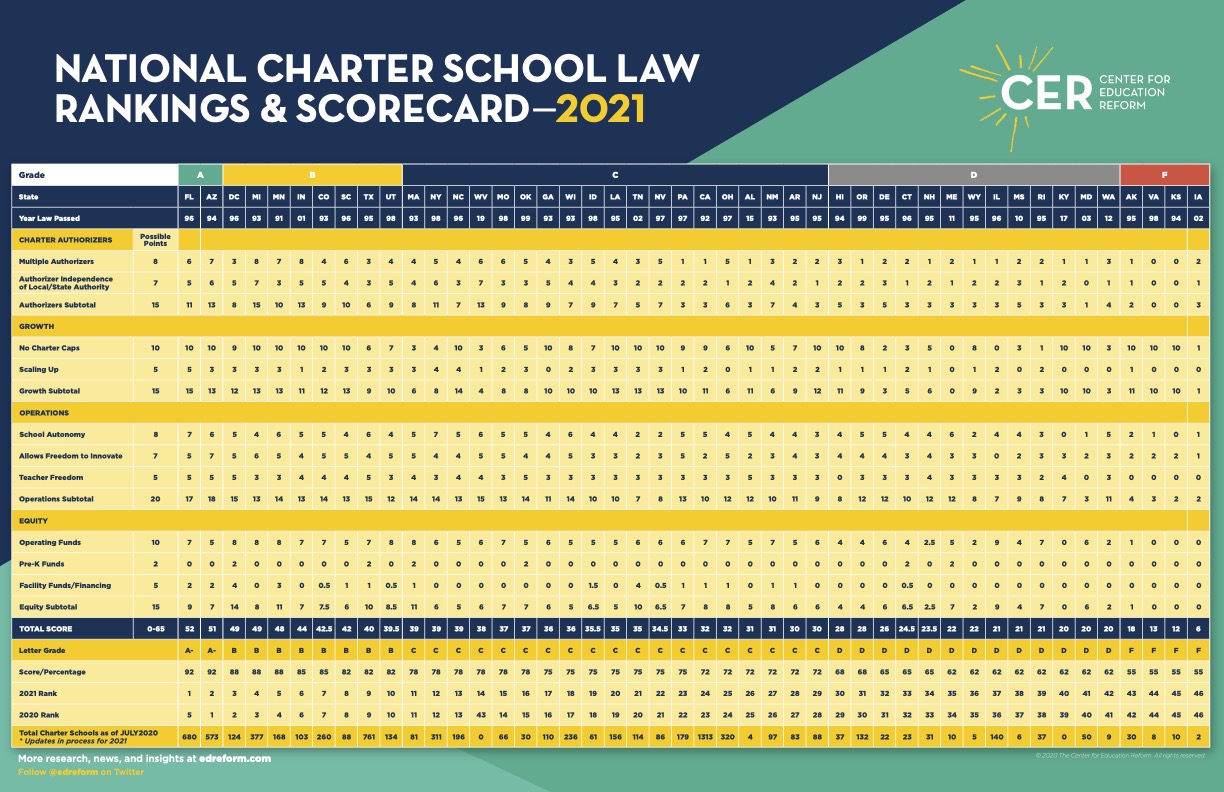JUST RELEASED:
National Charter School Law Rankings & Scorecard—2021
 The simple and original principle of charter schooling is that charter schools should receive enhanced operational autonomy in exchange for being held strictly accountable for the outcomes they promise to achieve. When charter school laws honor this principle, innovative, academically excellent charter schools flourish. In turn, schools that fail to produce strong outcomes close.
The simple and original principle of charter schooling is that charter schools should receive enhanced operational autonomy in exchange for being held strictly accountable for the outcomes they promise to achieve. When charter school laws honor this principle, innovative, academically excellent charter schools flourish. In turn, schools that fail to produce strong outcomes close.
Since the first charter schools were established in the 1990s, the movement has spread to every corner of the country, with concentrated growth in the nation’s largest urban centers. Over time, demand for charters has skyrocketed, despite setbacks deriving from weak charter school policies, overregulation, and false perceptions of charter schools promulgated by opponents of school choice.
One of the reasons parents and students seek charters is because, when they work, they offer options that are distinct from those found in most traditional school districts. The innovations that charters are best known for are extended school days and years and, in some places, one-to-one tutoring. But charters innovate in many other ways as well: from developing unique approaches to teacher training to pioneering tools for personalized learning, many innovations that are now accepted as common were born in the charter sector.
Also from CER:
Just the Facts: Success, Innovation, and Opportunity in Charter Schools (January 2017)
Charter schools are popular and innovative. They are also effective. But charter school success depends on the policy environments in which charter schools operate. Some state laws and regulations encourage diversity and innovation in the charter sector by providing multiple authorizers to support charter schools and allowing charters real operational autonomy. As Michael Q. McShane has pointed out, where diversity exists, charter schools have the opportunity to innovate.
Too many states, however, hamper charter schools with weak laws and needless regulations. These make it difficult to distinguish charters from their district counterparts.
Weak charter school laws have proven that when we apply the same old rules to district and charter schools, we get more of the same. Overregulation and underfunding force charters to behave as district schools by another name. Wouldn’t it make more sense to allow charters the room to innovate and succeed so that they could, in turn, help district schools subvert the status quo?
Since 1996 CER has researched, analyzed and ranked state charter school laws in an attempt to demonstrate how weak charter school laws create weak charter schools. These findings consider not only the content of each law, but also how the law impacts charter schools on the ground: How robust is the charter sector in each state? How diverse are the schools? To what extent do burdensome regulations prevent charters from doing anything meaningfully different?
As in years past, the national rankings carefully consider the impacts of overregulation, particularly on innovations in teaching and learning. And this year’s National Charter School Law Rankings & Scorecard goes a step further, providing case study examples of how regulations and other aspects of poorly conceived charter school policies impact charter operators and students. In addition to these case studies, CER also provides model legislation for policymakers to consider when crafting or amending charter school laws and regulations.
With this important guide, there is evidence-rich feedback and guidance to policymakers. With feedback and guidance, change is possible.

